Archiv der Kategorie: Hardware
Alexander Zorn vom Fraunhofer IAIS stellt KI gesteuerten Roboterarm im Robots-Blog Interview vor
Robots-Blog besucht Vention auf der automatica 2025. Andrea Alboni im Gespräch mit Sebastian Trella
Robots-Blog trifft Alexander Mühlens und igus ersten humanoiden Roboter „Iggy Rob“ auf der automatica
Volker Spanier präsentiert neuen Epson 6-Achs-Roboter Cobot AX6 im Robots-Blog Interview auf automatica 2025
KI-Gestenerkennung mit IDS NXT Kamera lässt igus ReBel Roboter Stein, Schere, Papier gegen Mensch spielen
Automatica 2025: Vention erweitert Angebot mit Robotiklösungen von Franka Robotics
MÜNCHEN, 17. Juni 2025 /PRNewswire/ — Vention, Anbieter der weltweit einzigen vollständig integrierten Software- und Hardware-Plattform für industrielle Automatisierung, erweitert sein Robotik-Portfolio um kollaborative Roboter der Franka Robotics GmbH, einer Tochtergesellschaft der in München ansässigen Agile Robots SE.
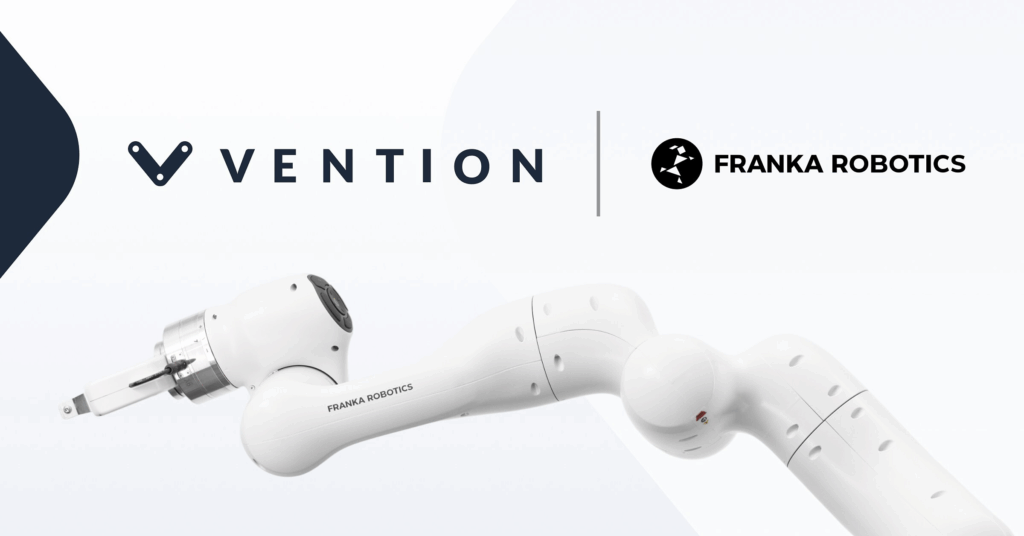
- Vention hat sein Roboterangebot um kollaborative Roboter der Franka Robotics GmbH erweitert, einem in Deutschland ansässigen Hersteller von Präzisions-Cobots, die in der Forschung und Entwicklung beliebt sind.
- Vention und Franka Robotics zeigen auf der Automatica PCB-Tests mit einem Franka Research 3 (FR3)-Roboter für die präzise und sichere Automatisierung empfindlicher Elektronik.
- Darüber hinaus präsentiert Vention KI-gestütztes Bin-Picking und ein All-in-One-Steuerungssystem für Bewegung, Bildverarbeitung, Sensorik und KI.
- MachineMotion™ AI, Ventions Steuerung der dritten Generation, feiert ihre Europapremiere mit einer KI-gestützten Bin-Picking-Demonstration auf einem ABB GoFa – inklusive intelligenter Teileerkennung und Greifpräzision im Submillimeterbereich.
- Modulare Roboterzellen für Maschinenbestückung und Palettierung werden ebenfalls gezeigt – mit führenden Robotermarken wie Universal Robots und FANUC.
- Besucher von Stand B4.307 erhalten kostenlosen Zugang zu MachineBuilder 101™, dem neuen Zertifikatskurs von Vention zur Planung, Simulation und Inbetriebnahme von Automatisierungslösungen auf der Vention-Plattform.
Franka Robotics hat sich mit seinem beliebten FR3-Roboterarm als führende Plattform in der akademischen Forschung etabliert und ist mittlerweile die bevorzugte Wahl für Doktoranden, KI-Forscher und Robotik-Labore. Mit der Aufnahme von Franka Robotics-Anwendungen in das eigene Portfolio erweitert Vention sein Angebot gezielt, um der starken Nachfrage von Hochschulen, Forschungseinrichtungen und innovationsgetriebenen Unternehmen gerecht zu werden, die bereits im Vention-Ökosystem arbeiten.
Vention präsentiert auf der Automatica 2025 (vom 24. bis 27. Juni) in München erstmalig eine Live-Demonstration mit einem FR3-Roboter von Franka Robotics (Stand B4.307).
„Wir sind stolz, Franka Robotics im Vention-Ökosystem begrüßen zu dürfen“, sagt Francois Giguere, Chief Technology Officer von Vention. „Der sehr gute Ruf von Franka Robotics im akademischen Umfeld passt perfekt zu unserer Mission, die industrielle Automatisierung zugänglicher und intuitiver zu gestalten. Wir freuen uns über die Zusammenarbeit mit einer angesehenen deutschen Marke – Deutschland hat die Geschichte von Vention von Anfang an maßgeblich geprägt, und diese Partnerschaft markiert ein spannendes neues Kapitel auf unserem Weg.“
„Die Partnerschaft mit Vention ermöglicht es uns, die Reichweite unseres Roboters Franka Research 3 einem breiteren Anwenderkreis im akademischen Bereich und in innovativen Anwendungen zugänglich zu machen“, erklärt Henrik Hermann, Vertriebsleiter bei Franka Robotics. „Gemeinsam setzen wir uns dafür ein, innovative, benutzerfreundliche Automatisierungslösungen zu liefern, die unseren Kunden neue Möglichkeiten in der Robotik und KI eröffnen.“
Der FR3 ist ein benutzerfreundlicher, kompakter und leichter (18 kg) Roboterarm mit sieben Freiheitsgraden. Er ist sicher, hochflexibel und damit ideal für Laborumgebungen mit begrenztem Platzangebot. Dank seiner drehmomentgeregelten Gelenke verfügt er über eine Echtzeit-Kraftsensorik, mit der er Kräfte wahrnehmen und darauf reagieren kann. Dies ist entscheidend für die Forschung zur Mensch-Roboter-Interaktion, das Lernen durch Demonstration sowie die Durchführung kontaktintensiver Aufgaben mit empfindlichen Komponenten.
Vention auf der Automatica 2025
Vention zeigt auf der Automatica insgesamt vier Live-Demonstrationen, die die vollständig integrierte Automatisierungsplattform des Unternehmens in der Praxis erlebbar machen – durch die Kombination aus intuitiver Software, modularer Hardware und den KI-gestützten Funktionen von MachineMotion™ AI.
MachineMotion™ KI & NVIDIA-Technologie – Leistungsstarke Bewegungssteuerung
Nach der NVIDIA GTC 2025 und der Automate in den USA stellt Vention seine KI-gestützten Bin-Picking-Demonstration mit einem ABB GoFa CRB 15000 erstmals auf einer europäischen Messe vor. Auf Basis von MachineMotion™ AI, NVIDIA Jetson Computing sowie CUDA-beschleunigten Isaac-Bibliotheken und -Modellen von NVIDIA deckt die Live-Demonstration von Vention fortschrittliche Robotik, KI-basierte Bewegungssteuerung und skalierbare Schulungsszenarien ab – und zeigt, welchen konkreten Mehrwert KI bei der praktischen Implementierung robotergestützter Lösungen in der Fertigung bietet. Die Anwendung erreicht eine Greifgenauigkeit im Submillimeterbereich bei ungeordneten Fertigungsteilen – ideal für High-Mix-/Low-Volume-Produktionsumgebungen.
Modulare Demos für praxisnahe Anwendungen
Im Rahmen Automatica wird Vention den FR3-Arm von Franka Robotics bei Leiterplattentests auf einer Vention-Workstation vorführen und die Präzision und schonende Handhabung für empfindliche Elektronik und feinmotorische Aufgaben demonstrieren.
Darüber hinaus erleben Besucher vollständig integrierte, anpassbare Roboterzellen für:
- 7th Axis Range Extender – für mehr Reichweite und Flexibilität bei Anwendungen wie Maschinenbestückung, Montage und Verpackung.
- Rapid Series Palletizer – aufgebaut auf einer Teleskopsäule und optimiert mit der neuesten Version 4.5 der MachineApp-Software von Vention.
Die Live-Demonstrationen finden in Halle B4, Stand 307 statt.
Weitere Informationen auf Vention.com.
ABot Advanced by Avishkaar
The Avishkaar ABot Advanced Kit is a comprehensive DIY kit for STEM robotics and coding designed specifically for children aged 8 and up. It contains over 60 parts, including metal parts, motors, sensors, wheels, USB cables, screws, nuts, an Allen wrench, and a wrench. With these parts, children can build 10 different robots, from simple vehicles to more complex constructions The set reminded me of the mBot when I set it up, as it was also based on a sturdy metal construction. The included stickers and the tool are nice. The instructions were easy to understand and I didn’t find any errors or had any problems assembling. The app for remote control and programming must be activated with the product code and the user must be registered before using it for the first time. When deploying, e.g. in the classroom, you should have done this in advance. By the way, the 9V block battery visible in the video is not included when purchased from a dealer, but a full-fledged battery pack. I only use the 9V battery because of delivery problems. Overall, however, it is interesting that the robot makes this possible at all. I’m playing with the idea of connecting a solar cell here and operating the robot with solar energy…like a real Mars rover…
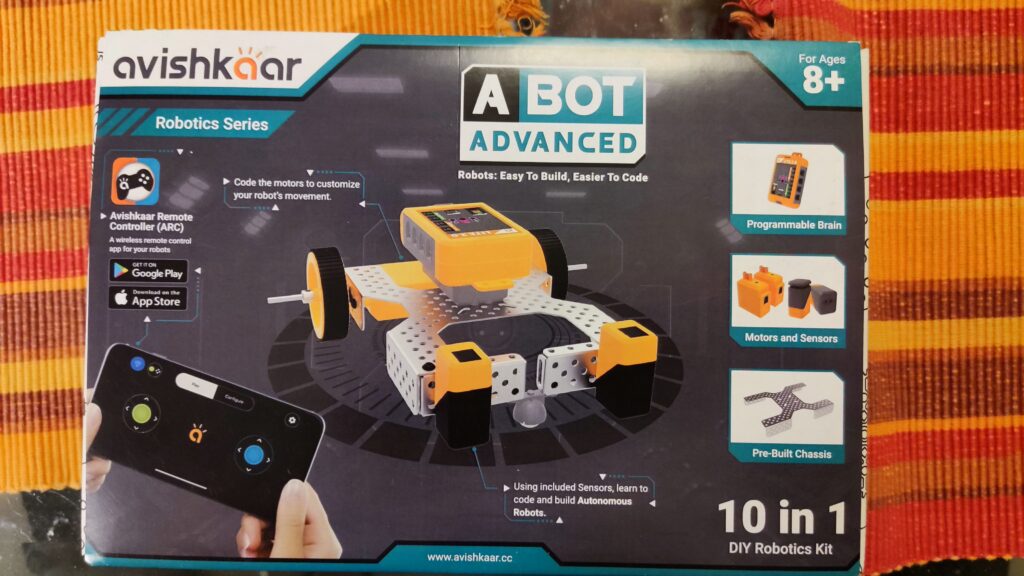
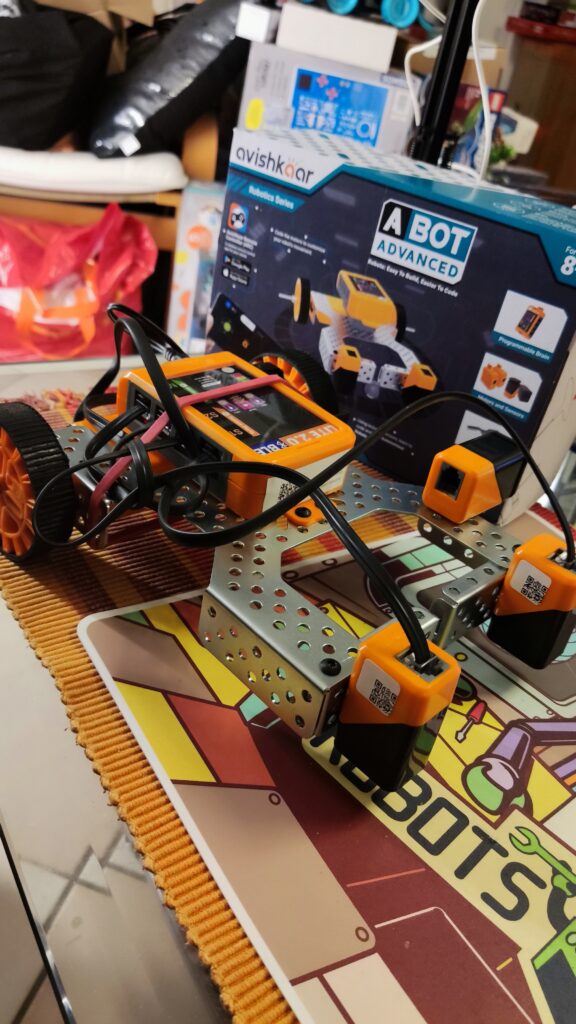
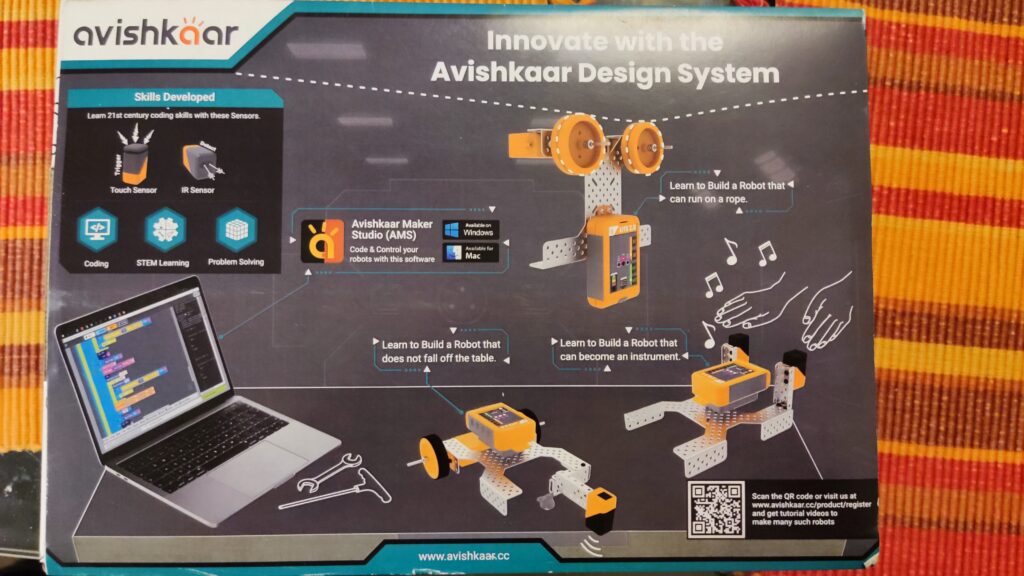
Here is more detailed information:
- Easy to build programmable robots: With this kit, kids can create 10 different robots with over 60 pieces. This includes metal parts, an easily programmable brain, motors, sensors (2x light sensor, 1x touch sensor/button), wheels, USB cables, screws, nuts, an Allen key, a wrench, cables, and instructions.
- Control via mobile app: The robots can be controlled via a remote control app. They can also be programmed using a visual block-based programming environment (similar to Scratch/Blockly).
- Learning Objectives: With the ABot Advanced Kit, children learn robotics, programming, construction, mechanical design and problem solving.
- Compatibility: The mobile app is compatible with iOS 11 or later and Android 10 or later.
- Inexpensive Kit: The ABot Advanced Kit offers a sturdy metal frame to which motors and sensors can be attached. For the equivalent of about 60€, the set offers good value for money. Maybe the set will soon be available at a German retailer.
You can find a comprehensive assembly video of one of the 10 robot models here:
The set is available here: https://shop.avishkaar.cc/products/abot-advanced
ABot Advanced by Avishkaar
Das Avishkaar ABot Advanced Kit ist ein umfassendes DIY-Set für STEM-Robotik und Codierung, das speziell für Kinder ab 8 Jahren entwickelt wurde. Es enthält über 60 Teile, darunter Metallteile, Motoren, Sensoren, Räder, USB-Kabel, Schrauben, Muttern, ein Inbusschlüssel und ein Schraubenschlüssel. Mit diesen Teilen können Kinder 10 verschiedene Roboter bauen, von einfachen Fahrzeugen bis hin zu komplexeren Konstruktionen Das Set erinnerte mich beim Aufbau an den mBot, da auch hier eine stabile Metallkonstruktion als Grundlage diente. Nett sind die mitgelieferten Sticker und das Werkzeug. Die Anleitung war einfach zu verstehen und ich fand keine Fehler oder hatte Probleme beim Zusammenbau. Die App zur Fernsteuerung und Programmierung muss vor der ersten Verwendung mit dem Produktcode aktiviert und der Benutzer registriert werden. Beim Einsatz, z.B. im Klassenzimmer, sollte man dies vorab schon erledigt haben. Die im Video sichtbare 9V Blockbatterie ist übrigens beim Kauf über einen Händler nicht dabei, sondern ein vollwertiges Akkupack. Ich verwende die 9V Batterie nur wegen Lieferschwierigkeiten. Insgesamt aber schon interessant, dass der Roboter dies überhaupt ermöglicht. Ich spiele direkt mit dem Gedanken hier eine Solarzelle anzuschließen und den Roboter mit Sonnenenergie zu betreiben…wie so ein richtiger Marsrover…



Hier sind weitere detaillierte Informationen:
- Einfach zu bauende programmierbare Roboter: Mit diesem Kit können Kinder 10 verschiedene Roboter mit über 60 Teilen erstellen. Dazu gehören Metallteile, ein leicht programmierbares Gehirn, Motoren, Sensoren (2x Lichtsensor, 1x Berührungssensor/Taster), Räder, USB-Kabel, Schrauben, Muttern, ein Inbusschlüssel, ein Schraubenschlüssel, Kabel und eine Anleitung.
- Steuerung über mobile App: Die Roboter können über eine Fernbedienungs-App gesteuert werden. Außerdem können sie mithilfe einer visuellen blockbasierten Programmierumgebung (ähnlich Scratch/Blockly) programmiert werden.
- Lernziele: Mit dem ABot Advanced Kit lernen Kinder Robotik, Programmierung, Konstruktion, mechanisches Design und Problemlösung.
- Kompatibilität: Die mobile App ist mit iOS 11 oder höher und Android 10 oder höher kompatibel.
- Preiswertes Kit: Das ABot Advanced Kit bietet einen stabilen Metallrahmen an dem Motoren und Sensoren angebracht werden können. Für umgerechnet ca. 60€ bietet das Set ein gutes Preis-Leistungsverhältnis. Vielleicht findet sich das Set ja auch bald bei einem deutschen Händler.
Ein umfassendes Aufbauvideos eines der 10 Robotermodelle findet ihr hier:
Das Set ist u.a. hier erhältlich: https://shop.avishkaar.cc/products/abot-advanced
automatica 2025: erster kollaborativer Roboter von Epson

Düsseldorf, 10. Juni 2025 – Epson, ein führender Anbieter von Roboter- und Automatisierungstechnik, stellt auf der automatica 2025 seine erste kollaborative Industrieroboterlösung vor. Diese ermöglicht in Branchen wie Fertigung, Logistik und dem sich schnell entwickelnden Life-Science-Sektor eine wirkungsvolle Interaktion zwischen Mensch und Maschine und steigert so die Effizienz und Produktivität. Die Lösung wird ab Herbst 2025 als erstes kollaboratives Roboter-Komplettpaket von Epson angeboten, welches den neuen, aus Carbon-Leichtbau bestehenden 6-Achs-Roboter AX6-A901S sowie die kompakte Epson RC-A101-Steuerung inklusive dem Programmiersystem AX-Portal umfasst.

„In den stark wachsenden Bereichen Biowissenschaften und pharmazeutische Industrie sind präzise Arbeitsabläufe und ein strenges Hygienemanagement von größter Bedeutung“, erklärt Volker Spanier, Head of Manufacturing Solutions von Epson. „Um auch diese Anforderungen zu erfüllen, ist der neue kollaborative Roboter von Epson reinraumtauglich. Dank seiner präzisen Bewegungen erlaubt die Maschine daher auch in Laboren und pharmazeutischen Einrichtungen die Verrichtung selbst komplizierter Aufgaben.“
Wichtige Produktmerkmale des kollaborativen Roboters AX6-A901S von Epson:
- Ausbalanciertes Design: Der AX6-A901S bewegt eine Nutzlast von bis zu 6 kg bei einer Armlänge von 900 mm. Er besitzt ein besonders leichtes und kompaktes Design, sodass sowohl sein Transport als auch seine Integration in bestehende Produktionslinien sehr einfach sind. Dank der kompakten Abmessungen lässt er sich auch in beengten Umgebungen einsetzen.
- Kompakter und leichter Controller: Der Epson RC-A101-Controller ist für die Installation auf fahrerlosen Transportfahrzeugen (AGVs) und autonomen, mobilen Robotern (AMRs) geeignet. Er hat die Abmessungen B 440 x T 205 x H 135 mm und wiegt weniger als 6 kg. Auch dieses kompakte Design ermöglicht eine sehr platzsparende Installation.
- Kompatibel zu verschiedenen Stromquellen: Der kollaborative Roboter ist mit Stromquellen von 100 bis 230 VAC bzw. 48 VDC kompatibel, sodass er in Umgebungen mit verschiedenen Stromquellen installiert werden kann.
- Reinraumkompatibilität: Der AX6-A901S besitzt die Reinraumklasse 5 nach ISO 14644-1 und die Schutzart IP54. Das glatte Gehäusedesign ohne Schraubenlöcher und scharfe Kanten minimiert die Staubansammlung und damit das Kontaminationsrisiko in Reinraumumgebungen.
- Python-Programmierung: Die Programmierumgebung unterstützt die weit verbreitete Programmiersprache Python. Diese Kompatibilität vereinfacht die Integration in alle F&E-Umgebungen und die Inbetriebnahme. Auch wird so das Erlernen einer neuen Programmiersprache unnötig.
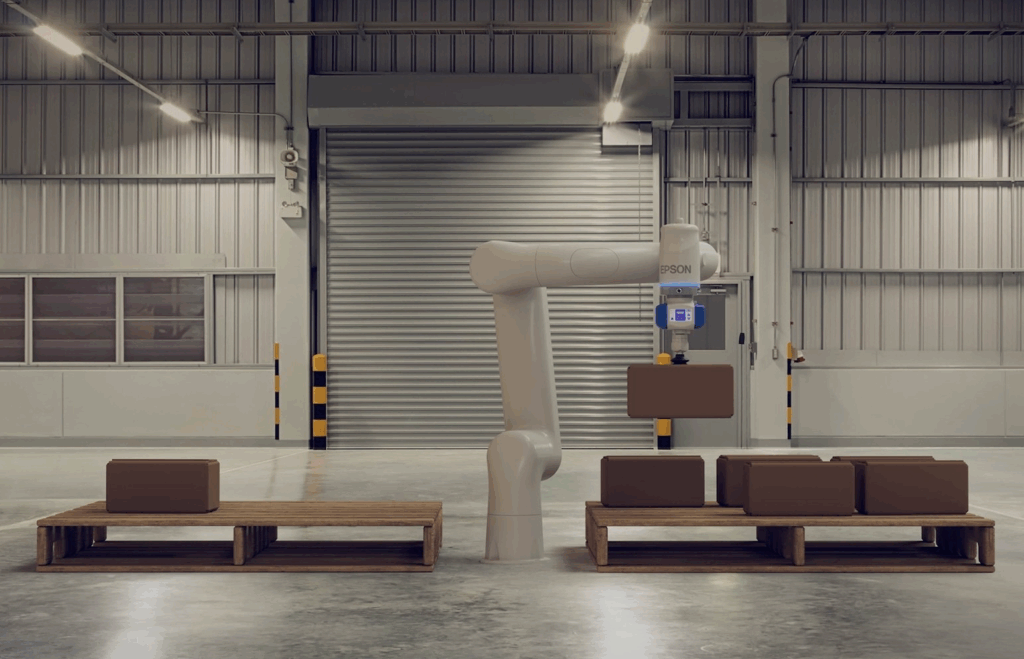
Spanier fasst zusammen: „Epsons Engagement für die Weiterentwicklung der Robotik resultiert in diesem kollaborativen Roboter, der auch sehr komplexe Aufgaben sicher ausführt. Damit erfüllen wir die wachsende Nachfrage der Labor- und Pharmaindustrie und weiteren Branchen. Diese Maschine stellt einen bedeutenden Fortschritt auf dem Weg zur Verbesserung des Epson Angebotes im Bereich der industriellen Automatisierung dar. Unsere Roboter erfüllen dabei auch die strikten Anforderungen des Life-Science-Sektors und gewährleisten Sicherheit und Präzision bei jeder Interaktion zwischen Mensch und Maschine.“
Zu den neuen Robotern gibt es am 24. Juni eine Pressekonferenz am Epson Stand 311 in Halle B5
Weitere Informationen zu den Robotiklösungen von Epson:
automatica 2025 | Epson Europe
